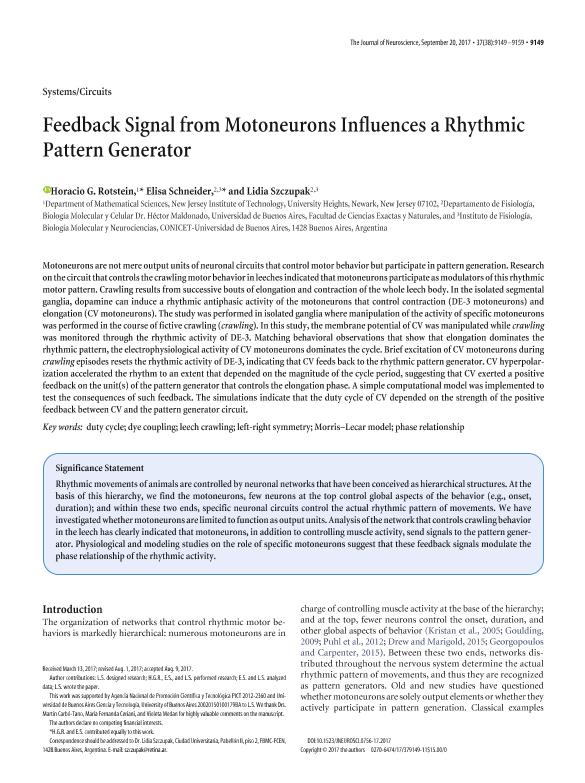Artículo
Feedback signal from motoneurons influences a rhythmic pattern generator
Fecha de publicación:
20/09/2017
Editorial:
Society for Neuroscience
Revista:
Journal of Neuroscience
ISSN:
0270-6474
Idioma:
Inglés
Tipo de recurso:
Artículo publicado
Clasificación temática:
Resumen
Motoneurons are not mere output units of neuronal circuits that control motor behavior but participate in pattern generation. Research on the circuit that controls the crawling motor behavior in leeches indicated that motoneurons participate as modulators of this rhythmic motor pattern. Crawling results from successive bouts of elongation and contraction of the whole leech body. In the isolated segmental ganglia, dopamine can induce a rhythmic antiphasic activity of the motoneurons that control contraction (DE-3 motoneurons) and elongation (CV motoneurons). The study was performed in isolated ganglia where manipulation of the activity of specific motoneurons was performed in the course of fictive crawling (crawling). In this study, the membrane potential of CV was manipulated while crawling was monitored through the rhythmic activity of DE-3. Matching behavioral observations that show that elongation dominates the rhythmic pattern, the electrophysiological activity of CV motoneurons dominates the cycle. Brief excitation of CV motoneurons during crawling episodes resets the rhythmic activity of DE-3, indicating that CV feeds back to the rhythmic pattern generator. CV hyperpolarization accelerated the rhythm to an extent that depended on the magnitude of the cycle period, suggesting that CV exerted a positive feedback on the unit(s) of the pattern generator that controls the elongation phase. A simple computational model was implemented to test the consequences of such feedback. The simulations indicate that the duty cycle of CV depended on the strength of the positive feedback between CV and the pattern generator circuit.
Archivos asociados
Licencia
Identificadores
Colecciones
Articulos(IFIBYNE)
Articulos de INST.DE FISIOL., BIOL.MOLECULAR Y NEUROCIENCIAS
Articulos de INST.DE FISIOL., BIOL.MOLECULAR Y NEUROCIENCIAS
Citación
Rotstein, Horacio; Schneider, Elisa; Szczupak, Lidia; Feedback signal from motoneurons influences a rhythmic pattern generator; Society for Neuroscience; Journal of Neuroscience; 37; 38; 20-9-2017; 9149-9159
Compartir
Altmétricas




